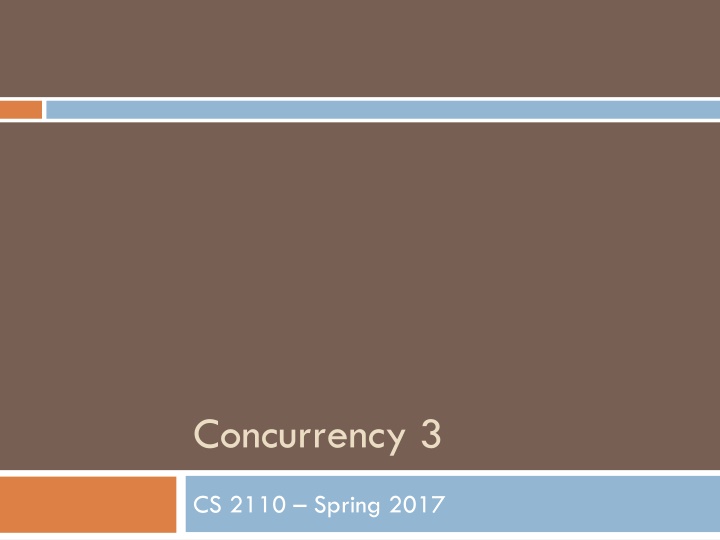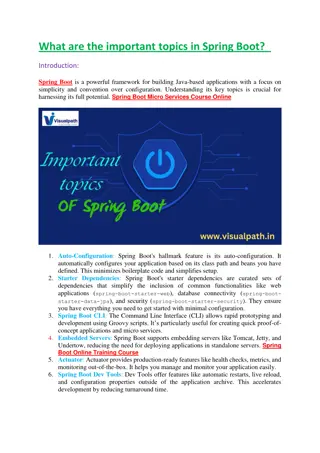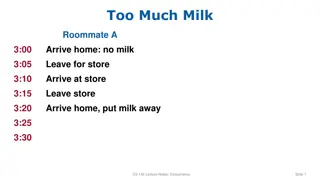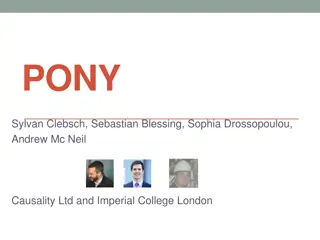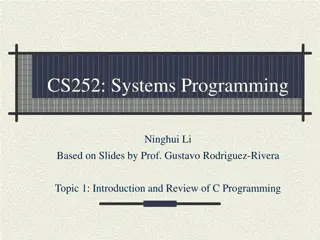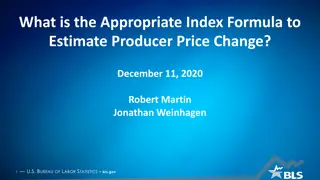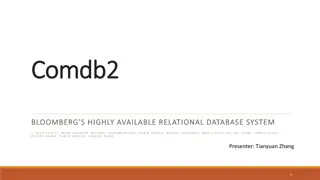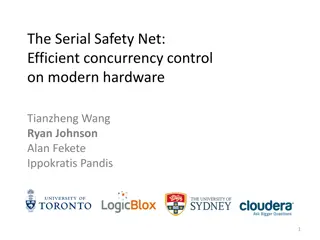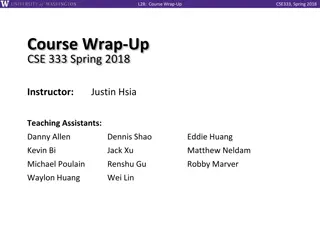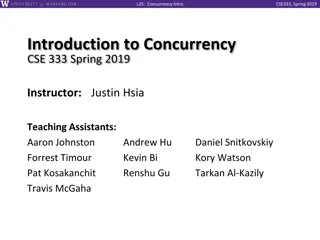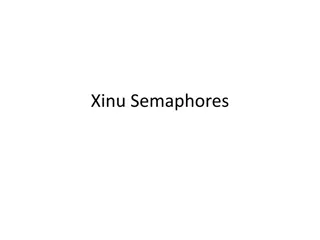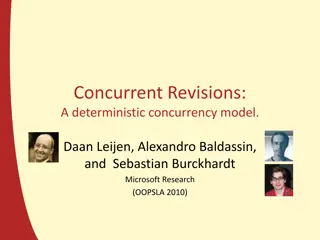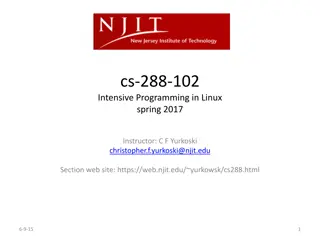Concurrency: Spring 2017 Course Announcements & Axiomatic Programming Basics
Dive into the world of concurrency with insights from the CS 2110 Spring 2017 course. Explore the importance of course evaluations and Hoare's axiomatization of programming languages. Learn about assignment statements, if statements as inference rules, and Hoare's contributions to the field. Discover how to ensure program correctness through proofs and explore the evolution of programming discipline with Dijkstra's groundbreaking concepts.
Download Presentation

Please find below an Image/Link to download the presentation.
The content on the website is provided AS IS for your information and personal use only. It may not be sold, licensed, or shared on other websites without obtaining consent from the author.If you encounter any issues during the download, it is possible that the publisher has removed the file from their server.
You are allowed to download the files provided on this website for personal or commercial use, subject to the condition that they are used lawfully. All files are the property of their respective owners.
The content on the website is provided AS IS for your information and personal use only. It may not be sold, licensed, or shared on other websites without obtaining consent from the author.
E N D
Presentation Transcript
Concurrency 3 CS 2110 Spring 2017
Announcements Course evaluations: we care. We care so much we make it 1% of your grade. At the end of May 11th, we see a list of which students submitted evaluations. After grades are submitted, we see the anonymized content of the evaluations. We read them all. When giving feedback, please strive for specificity and constructiveness.
Axiomatic Basis for Computer Programming. Tony Hoare, 1969 Provide a definition of programming language statements not in terms of how they are executed but in terms of proving them correct. {precondition P} Statement S {Postcondition Q) Meaning: If P is true, then execution of S is guaranteed to terminate and with Q true
Assignment statement x= e; {true} x= 5; {x = 5} {x+1 >= 0} x= x + 1; {x >= 0} {2*x = 82} x= 2*x; {x = 82} Definition of notation: P[x:= e] (read P with x replaced by e) stands for a copy of expression P in which each occurrence of x is replaced by e Example: (x >= 0)[x:= x+1] = x+1 >= 0 Definition of the assignment statement: {P[x:= e]} x= e; {P}
Assignment statement x:= e; Definition of the assignment statement: {P[x:= e]} x= e; {P} {x+1 >= 0} x= x + 1; {x >= 0} {2*x = 82} x= 2*x; {x = 82} x = x/6 { x= 2.0*x*y + z; {x = x/6} 2.0xy + z = (2.0xy + z)/6 } 2.0xy + z = (2.0xy + z)/6 5
If statement defined as an inference rule: Definition of if statement: If {P && B} ST {Q} and {P && !B} SF {Q} Then {P} if (B) ST else SF {Q} The then-part, ST, must end with Q true The else-part, SF, must end with Q true 6
Hoares contribution 1969: Axiomatic basis: Definition of a language in terms of how to prove a program correct. But it is difficult to prove a program correct after the fact. How do we develop a program and its proof hand-in- hand? Dijkstra showed us how to do that in 1975. His definition, called weakest preconditions is defined in such a way that it allows us to calculate a program and its proof of correctness hand-in-hand, with the proof idea leading the way. Dijkstra: A Discipline of Programming. Prentice Hall, 1976. A research monograph Gries: The Science of Programming. Springer Verlag, 1981. Undergraduate text. 7
How to prove concurrent programs correct. Use the principle of non-interference T1 and T2 are proved correct in isolation. Thread T1 {P0} S1; {P1} S2; {P2} Sn; {Pn} Thread T2 {Q0} Z1; {Q1} Z2; {Q2} Zm; {Qm} What happens when T1 and T2 execute simultaneously? How many execution orders are there? 8
How to prove concurrent programs correct. Use the principle of non-interference T1 and T2 are proved correct in isolation. S1; S2; Sn; Z1; Z2; Zm; What happens when T1 and T2 execute simultaneously? m+n instructions to execute: choose m of them for the Z s S s in the rest. How many execution orders are there? ? + ? ! ?! ?! ? + ? ? = = ? ???? ??? ?????? 9
How to prove concurrent programs correct. Thread T1 Thread T2 {P0} S1; {P1} S2; {P2} Sn; {Pn} {Q0} Z1; {Q1} Z2; {Q2} Zm; {Qm} Turn what previously seemed to be an exponential problem, looking at all executions, into a problem of size n*m. Prove that execution of T1 does not interfere with the proof of T2, and vice versa. Basic notion: Execution of Si does not falsify an assertion in T2: e.g. {Pi && Q1} S2 {Q1} 10
Interference freedom. Susan Owicki s Cornell thesis, under Gries, in 1975. Thread T1 Thread T2 {P0} S1; {P1} S2; {P2} Sn; {Pn} {Q0} Z1; {Q1} Z2; {Q2} Zm; {Qm} A lot of progress since then! But still, there are a lot of hard issues to solve in proving concurrent programs correct in a practical manner. Prove that execution of T1 does not interfere with the proof of T2, and vice versa. Basic notion: Execution of Si does not falsify an assertion in T2: e.g. {Pi && Q1} S2 {Q1} 11
A new way to melt your computer! public class ForkBomb extends Thread { public static void main(String[] args) { (new ForkBomb()).start(); } public @Override void run() { (new ForkBomb()).start(); (new ForkBomb()).start(); } }
Atomicity int x = 0; Thread 1 Thread 2 x++; x++; What is the value of x? Can be either 1 or 2!
Caching and Volatile Concurrent programming is hard. Concurrent programming on real hardware is even harder! Data is stored in caches Only written to main memory occasionally Huge efficiency gains! Huge concurrency headaches!
Caching and Volatile Concurrent programming is hard. Concurrent programming on real hardware is even harder! Volatile keyword Fields can be declared volatile All local changes are made visible to other threads Does not guarantee atomicity! x+= 1 still does get, add, set; these may still be interleaved
Atomicity volatile int x = 0; Thread 1 Thread 2 x++; x++; What is the value of x? Can be either 1 or 2!
Can we get atomicity without locks? class AtomicInteger, AtomicReference<T>, Represents a value method set(newValue) has the effect of writing to a volatile variable method get() returns the current value If the OS controls thread execution, how can the language ever guarantee atomicity? New concurrency primitives: atomic operations.
Compare and Set (CAS) boolean compareAndSet(expectedValue, newValue) If value doesn t equal expectedValue, return false if equal, store newValue in value and return true executes as a single atomic action! supported by many processors as hardware instructions does not use locks! AtomicInteger n = new AtomicInteger(5); n.compareAndSet(3, 6); // return false no change n.compareAndSet(5, 7); // returns true now is 7
Incrementing with CAS /** Increment n by one. Other threads use n too. */ public static void increment(AtomicInteger n) { int i = n.get(); while (n.compareAndSet(i, i+1)) i = n.get(); } // AtomicInteger has increment methods that do this
Lock-Free Data Structures Usable by many concurrent threads using only atomic actions no locks! compare and swap is your best friend but it only atomically updates one variable at a time! Let s look at one! Lock-free binary search tree [Ellen et al., 2010] http://www.cs.vu.nl//~tcs/cm/cds/ellen.pdf
Concurrency in other languages Concurrency is an OS-level concern Platform-independent languages often provide abstractions on top of these. Java, Python, Matlab, ... Different platforms have different concurrency APIs for compiled languages. Unix/Linux: POSIX Threads (Pthreads) Mac OS (based on Unix!): Pthreads, NSThread Windows APIs iOS: ?? Android: ??
Graph Search Do you need to travel to a node to visit it? vs
Graph Search Do you need to travel to a node to visit it? Depends on what information you have about the graph. Self-driving car (e.g., Uber) with nothing but sensors: needs to explore to find its destination. Self-driving car (e.g. Waymo) with Google Maps: compute a path, then follow it.
Graph Search Let s consider BFS. /** Visit all nodes REACHABLE* from u. Pre: u is unvisited. */ public static void bfs(int u) { Queue q= (u); while q is not empty) { u= q.popFirst(); if (u has not been visited) { visit u; for each edge (u, v) leaving u: q.append(v); } } } E C A B X
Graph Search Let s consider BFS if you re Google. /** Visit all nodes REACHABLE* from u. Pre: u is unvisited. */ public static void bfs(int u) { Queue q= (u); while q is not empty) { u= q.popFirst(); if (u has not been visited) { visit u; for each edge (u, v) leaving u: q.append(v); } } } E C A B X
Graph Search Let s consider BFS if you re Uber (no Google Maps!*). /** Visit all nodes REACHABLE* from u. Pre: u is unvisited. */ public static void bfs(int u) { Queue q= (u); while q is not empty) { u= q.popFirst(); if (u has not been visited) { visit u; for each edge (u, v) leaving u: q.append(v); } } } E C A B X *allegedly
If a method moves a robot Your method s spec needs to say where the robot starts and ends in all possible scenarios. /** Drive in a square with side length size, starting out in the current direction. Car ends in the same location and direction as it started. */ public void driveInSquare(int size) { for (int i = 0; i < 4; i += 1) { forward(size); turn(90); } }
What is this course good for? Wrapping up the course Where can you go from here?
Coding Interviews A quick web search reveals: We ve taught you most of what you need for coding interviews. https://www.reddit.com/r/cscareerquestions/co mments/20ahfq/heres_a_pretty_big_list_of_pr ogramming_interview/ http://maxnoy.com/interviews.html Your interviewer will be impressed* if you: Write specs before you write methods. Talk about/write invariants for your loops. ... *If not, don t work there.
What else is there? This course scratches the surface of many subfields of CS. Topics that have 4000-level courses: Analysis of algorithms Computational complexity Compilers (parsing, grammars) Programming Languages (formal semantics, ...) Applied Logic (correctness proofs, ...) Operating Systems (concurrency, caching, ) Artificial Intelligence (graph searching, ...) ...among others. *If not, don t work there.
